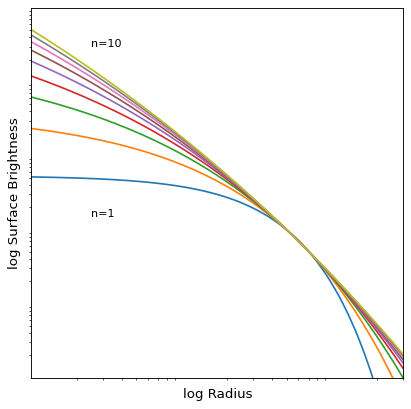Sersic1D系列#
- class astropy.modeling.functional_models.Sersic1D(amplitude=1, r_eff=1, n=4, **kwargs)[源代码]#
-
一维Sersic表面亮度分布。
- 参数:
- amplitude :
floatPython :浮点 表面亮度为
r_eff。- r_eff :
floatPython :浮点 有效(半光)半径。
- n :
floatPython :浮点 控制轮廓形状的序列索引。的特定值
n相当于以下配置文件:N=4 : de Vaucouleurs \(r^{1/4}\) 轮廓
N=1:指数分布
N=0.5:高斯分布
- amplitude :
- 其他参数:
- fixed :
dict,可选Python:Dict,可选 字典
{{parameter_name: boolean}}在拟合过程中不能改变的参数。True表示参数保持不变。或者fixed可以使用参数的属性。- tied :
dict,可选Python:Dict,可选 字典
{{parameter_name: callable}}链接到其他参数的参数。字典值是提供链接关系的可调用项。或者tied可以使用参数的属性。- bounds :
dict,可选Python:Dict,可选 字典
{{parameter_name: value}}参数的上下界。键是参数名。值是一个长度为2的列表或元组,为参数提供所需的范围。或者min和max可以使用参数的属性。- eqcons :
list,可选Python:列表,可选 长度函数列表
n这样的话eqcons[j](x0,*args) == 0.0在一个成功优化的问题中。- ineqcons :
list,可选Python:列表,可选 长度函数列表
n这样的话ieqcons[j](x0,*args) >= 0.0是一个成功优化的问题。
- fixed :
参见
笔记
的
r和r_eff输入必须具有兼容的单位或无单位数字。模型公式:
\[I(r) = I_{e} \exp\left\{ -b_{n} \left[\left(\frac{r}{r_{e}}\right)^{(1/n)} -1\right]\right\}\]哪里 \(I_{e}\) 是
amplitude和 \(r_{e}\) 是reff。常量 \(b_{n}\) 被定义为 \(r_{e}\) 包含总光度的一半。它可以从以下方程中进行数值求解:
\[\Gamma(2n)=2\Gamma(2n,b_{n})\]哪里 \(\Gamma(a)\) 是 gamma function 和 \(\gamma(a, x)\) 是 lower incomplete gamma function 。
工具书类
实例
import numpy as np from astropy.modeling.models import Sersic1D import matplotlib.pyplot as plt plt.figure() plt.subplot(111, xscale='log', yscale='log') s1 = Sersic1D(amplitude=1, r_eff=5) r = np.arange(0, 100, 0.01) for n in range(1, 10): s1.n = n plt.plot(r, s1(r)) plt.axis([1e-1, 30, 1e-2, 1e3]) plt.xlabel('log Radius') plt.ylabel('log Surface Brightness') plt.text(0.25, 1.5, 'n=1') plt.text(0.25, 300, 'n=10') plt.xticks([]) plt.yticks([]) plt.show()

属性摘要
此属性用于指示evaluate方法所需的单元或单元集,并返回将输入映射到单元(或
None如果接受任何单位)。描述此类型模型的参数的名称。
方法总结
evaluate(r, amplitude, r_eff, n)一维Sersic剖面函数。
属性文档
- amplitude = Parameter('amplitude', value=1.0)#
- input_units#
- n = Parameter('n', value=4.0)#
- param_names = ('amplitude', 'r_eff', 'n')#
描述此类型模型的参数的名称。
此元组中的参数与初始化特定类型的模型时应传入的顺序相同。某些类型的模型,如多项式模型,根据模型的某些其他属性(如阶数)有不同数量的参数。
定义自定义模型类时,此属性的值由
Parameter在类中定义的body属性。
- r_eff = Parameter('r_eff', value=1.0)#
方法文件

